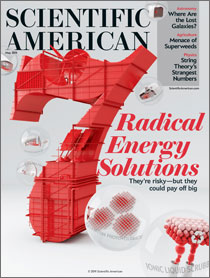Extrasensory Pornception
Does new research prove paranormal precognition or normal postcognition?

PSI, OR THE PARANORMAL, denotes anomalous psychological effects that are currently unexplained by normal causes. Historically such phenomena eventually are either accounted for by normal means, or else they disappear under controlled conditions. But now renowned psychologist Daryl J. Bem claims experimental proof of precognition (conscious cognitive awareness) and premonition (affective apprehension) “of a future event that could not otherwise be anticipated through any known inferential process,” as he wrote recently in “Feeling the Future” in the Journal of Personality and Social Psychology.
Bem sat subjects in front of a computer screen that displayed two curtains, behind one of which would appear a photograph that was neutral, negative or erotic. Through 36 trials the subjects were to preselect which screen they thought the image would appear behind, after which the computer randomly chose the window to project the image onto. When the images were neutral, the subjects did no better than 50–50. But when the images were erotic, the subjects preselected the correct screen 53.1 percent of the time, which Bem reports as statistically significant.
Bem calls this “retroactive influence”—erotic images ripple back from the future—or as comedian Stephen Colbert called it when he featured Bem on his show The Colbert Report, “extrasensory pornception.”
For many reasons, I am skeptical. First, over the past century dozens of such studies proclaiming statistically significant results have turned out to be methodologically flawed, subject to experimenter bias and nonreproducible. This assessment by University of Amsterdam psychologist Eric-Jan Wagenmakers appeared along with Bem’s study in the same journal.
Second, Bem’s study is an example of negative evidence: if science cannot determine the causes of X through normal means, then X must be the result of paranormal causes. Ray Hyman, an emeritus professor of psychology at the University of Oregon and an expert on assessing paranormal research, calls this issue the “patchwork quilt problem” in which “anything can count as psi, but nothing can count against it.” In essence, “if you can show that there is a significant effect and you can’t find any normal means to explain it, then you can claim psi.”
Third, paranormal effects, which are rarely allegedly detected at all, are always so subtle and fleeting as to be useless for anything practical, such as locating missing persons, gambling, investing, and so on.
Fourth, a small but consistent effect might be significant (for example, in gambling or investing), but according to Hyman, Bem’s 3 percent above-chance effect in experiment 1 was not consistent across his nine experiments, which measured different effects under varying conditions.
Fifth, experimental inconsistencies plague such research. Hyman notes that in Bem’s first experiment, the first 40 subjects were exposed to equal numbers of erotic, neutral and negative pictures. Then he changed the experiment midstream and, for the remaining subjects, just compared erotic images with an unspecified mix of all types of pictures. Plus, Bem’s fifth experiment was conducted before his first, which raises the possibility that there might be a post hoc bias either in running the experiments or in reporting the results. Moreover, Bem notes that “most of the pictures” were selected from the International Affective Picture System, but he does not tell us which ones were not, why or why not, or what procedure he employed to classify images as erotic, neutral or negative. Hyman’s list of flaws numbers in the dozens. “I’ve been a peer reviewer for more than 50 years,” Hyman told me, “and I can’t think of another reviewer who would have let this paper through peer review. They were irresponsible.”
Perhaps they missed what psychologist James Alcock of York University in Toronto found in Bem’s paper entitled “Writing the Empirical Journal Article” on his website, in which Bem instructs students: “Think of your data set as a jewel. Your task is to cut and polish it, to select the facets to highlight, and to craft the best setting for it. Many experienced authors write the results section first.”
Bem has responded (www.dbem.ws), but I have a premonition his precognition was a postcognition.

